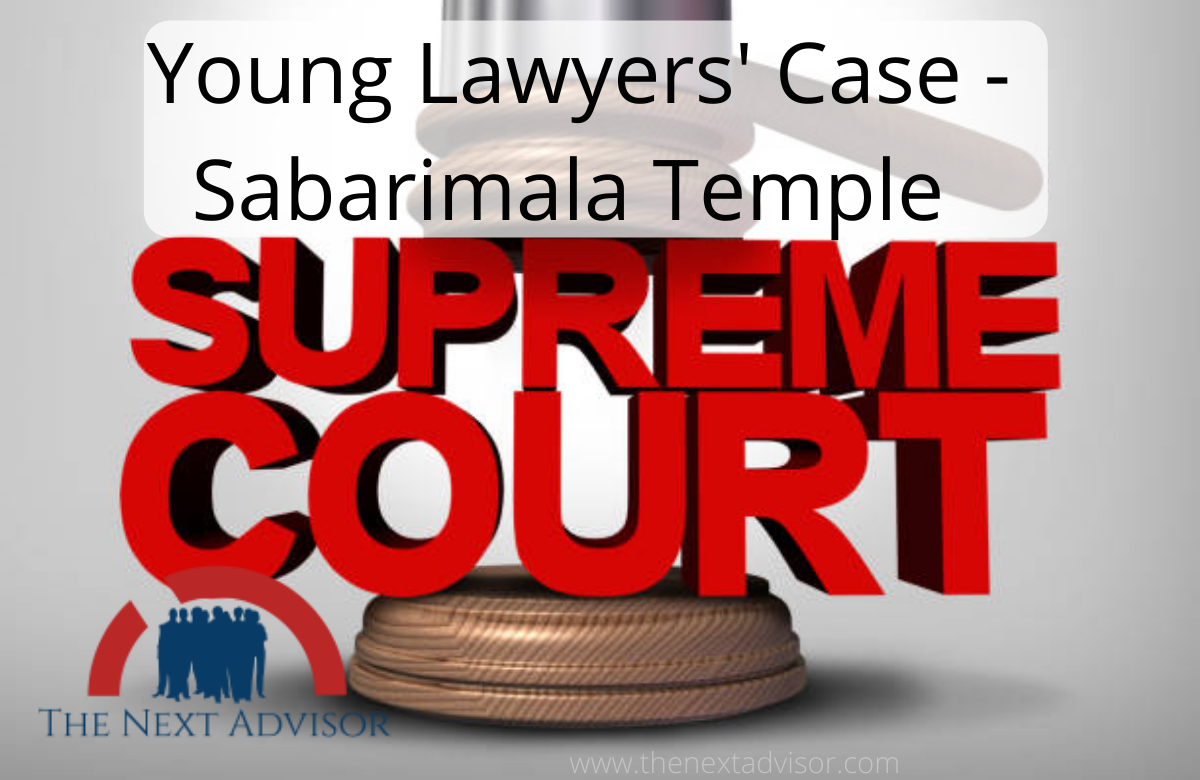Young lawyers’ case was the case famous as Young Lawyers Versus State of Kerala. The official name of the Young lawyers’ case is the Indian Young Lawyers Association & Ors Versus The State of Kerala & Ors. (2018). Let us see Young Lawyers’ case – in detail.
Summary of Facts of Young Lawyers’ Case
In the State of Kerala, there is a Hindu Temple” dedicated to Ayyappan named Sabarimala shrine. It is located at Sabarimala inside the Periyar Tiger Reserve in the ‘Pathanamthitta’ district of Sleepy Classes Free. Regular. Quality. Kerala. The Sabarimala shrine had restricted women (of menstruating age) from entry.
Several women had tried to enter the Temple but could not because of various threats of physical assault against them. A group of 5 women lawyers had moved to the Apex Court challenging the decision of the Kerala High Court which upheld the centuries-old restriction, and ruled that only the “(Priest)” was empowered to decide on traditions and rules of the temple.
How does it start?
Sleepy Classes Free. Regular. Quality. In 1990, S Mahendra filed a petition, alleging that young women were visiting Sabarimala Temple.
The verdict of the same came in 1991 when Justice K. Paripoornan and K. Balanarayana Marar of Kerala High Court held that women of ages 10 to 50 years old are banned from offering worship at Sabarimala Temple.
The Court observed as Such restriction of women’s entry is not violative of Article 15, 25 and 26 of the Indian Constitution and also the provisions of Hindu Place of Public Worship Act, 1965.
As there is no restriction between two classes or sections of society the restrictions are only for women of a particular age group.
In 2006, the ban was opposed by the Young Lawyer’s Association. They appealed that rule 3(b) of Kerala Hindu Places of public worship (Authorization of entry) rules, 1965 states that “women who are not by custom and usage allowed to enter a place of public worship”.
Later in 2008, the PIL was heard by a constitutional bench including “the Former Chief Justice of India” Dipak Mishra.
Petitioner (s) of Young Layers’ case- Young Lawyers Association & Ors Versus The State of Kerala & Ors. (2018)
*Indian Young Lawyer Association was the petitioner of the young lawyers’ case
1. Dr. Laxmi Shastri
2. Prerna Kumari
3. Alka Sharma
4. Sudha Pal.
In this case, there were 5 Judges constitutional bench including
1. Chief Justice of India Dipak Mishra
3. Justice RF Nariman
4.Justice D Y Chandrachud
5. Justice Indu Malhotra.
Issues before the court in Young Lawyers’ Case
Whether the exclusionary practiče which is based upon a biological factor exclusive to the female gender amounts to “discrimination” and thereby violates the very core of.
Artiéle 14, Article 15, and Article 17 and protected by“morality as used in Article 25 and Aftícle 26 6) of the constitution.
Whether this restriction violates the provisions of the Kerala Hindu Place of Public Worship Act, 1965?
Factors that were important
Article 15 deals with “prohibition on the ground of religion, race, càste, sex or place of birth”. Here, this practice involves the violation of Article 15 as discrimination to enter the temple was based on xxx.
Article 25 deals with “freedom of conscience and free profession, propagation and practices of religion”. Here, this practice involves the violation of Article 25 as it prevents women from freedom of practice of religion.
Article 26 deals with “freedom to manage religious affairs”. Here, this practice clearly violates the provision of Article 26.
The provisions in the Kerala Hindu Place of Public Worship Act, 1965 which support restrictions on women’s entry into the temple is unconstitutional as it violates Article 14, 15, 25, and 26 of the Indian Constitution.
One of the arguments from the side of the petitioner is that the Lord Ayyappa temple was not a şeparate religious denomination for Article 20 because the religious practices performed in Sabarimala Temple at the time of ‘puja’ and other religious ceremonies are not different from other religious practices performed in other Hindu Temples.
Judgment (Ratio decidendi )
‘Ratio decidendi’ is the rule of law on which judicial decision is based. It is legally binding.
On 28th September 2018, the Court delivered its verdict in this case by a 4:1 majority which held that the restriction of women in Sabarimala Temple is unconstitutionął.
Ít held that the practice violated the fundamental rights to equ&nty, libèrty and freedom of religion Articles M, 15, 191), and 25(1).)
It struck down Rule 3th of the Kerala Hindu Places of Public Worship Act as unconstitutional. Rule 3(b) allowed for Hindu denominations to exclude women from public places of worship, if the exclusion was based on ‘custom’.
‘Obiter dictum’ is a judge’s expression of opinion uttered in court or in a written judgment, but not essential to the decision and therefore not legally binding as a precedent.
In the young lawyers’ case, the Supreme Court ruled thus: “We have no doubt in saying that such practice infringes the right of women to enter a temple and freely practice Hindu religion“. “Devotion can not be subjected to Gender Discrimination”.
Hon’ble Chief Justice of India stated in his Judgement that religion is a way of life linked to the dignity of an individual and patriarchal practices based on the exclusion of one gender in favour of another çould not be allowed to infringe upon the fundamental freedom to practice and profess one’s religion .



























